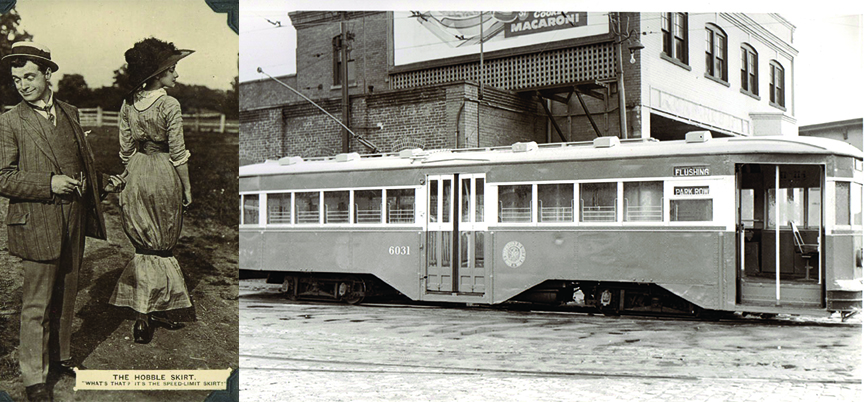Maspeth, Queens’ original European colony, sitting along Newtown creek, untouched by Manhattan’s 19th Century spider-web elevated railway network, clings to Brooklyn like a barnacle.
Long before there were miniskirts in Maspeth, there were “hobble skirts,” BRT” hobble skirts,” that is.
Around the time period immediately preceding World War I, the BRT suddenly had to increase its trolley fleet. A new type of streetcar was developed. A prototype (No. 3557) was built in the BRT shops in 1912. Having proved to be successful, one hundred similar cars (5000 to 5099) were built by J. G. Brill of Philadelphia. These cars were the first of the low-floor, center entrance cars to appear in Brooklyn. Nicknamed “hobbleskirts,” after the long women’s skirts in vogue during the early years of the 20th Century, the “hobbleskirt” cars were built with extremely low steps, allowing a woman a more dignified entrance into the car.
“Hobble-Skirts” Come to Maspeth
Following the success of the 5000 series “Hobbleskirts,” one hundred trailers (6000 to 6099) of a modified “hobbleskirt” design were built in 1919 and connected to large 4-motor convertibles (having removable side panels for summer operation) of the 4100 and 4300 series, forming trolley trains. These trolley trains were used on heavily traveled lines with loops on both ends. One such line was Flushing Avenue, which passed the Brooklyn Navy Yard and had loops at Park Row on the Manhattan side of the Brooklyn Bridge and the Maspeth Depot at Grand Avenue and 69th Street. Trolley train operation was short lived, ending in 1924 when Mayor John Francis Hylan banned trolley trains from New York City streets. “Hobble Skirts” continued to run along Flushing Avenue’s single units rebuilt in 1931 to one-man operation.
During the first half of the 20th Century, Maspeth witnessed a pageant of Brooklyn trolley fashion, notably the 8000 series Peter Witt, flagship of the BMT trolley fleet, as familiar to Brooklynites as Ebbetts Field or the brownstone. With three trolley lines – Grand Street, Flushing Avenue, and Flushing-Ridgewood – passing the landmark Maspeth Depot (built in 1884,) located at Grand Avenue and 69th Street, Maspeth was a veritable showcase of Brooklyn trolley fashion. “Hobbleskirts” remained in vogue until 1948 when the final one was scrapped.
Brooklyn trolleys went out of vogue in Maspeth on December 1, 1949, when Grand Street, the last Maspeth Streetcar line, received (Q59) busses. In 1952, the landmark Maspeth Depot was demolished to make way for the LIE. While a sea of red brick houses swept in a Queens neighborhood look, a thread of Brooklyn fashion remained in Maspeth until July 27, 1960, when the Flushing Avenue trackless trolley line was converted to diesel buses, thus making Maspeth the last Queens Community to sport the Brooklyn fashion trolley wires over a street.,
Today, Maspeth is a neighborly, up-to-date community, a member of the JPCA, and truly fashionable.
This story is dedicated to the memory of
Jean A. Roberts (1937-2004)
© 2020 The Juniper Park Civic Association Inc. All Rights Reserved.
SERVING MIDDLE VILLAGE AND MASPETH SINCE 1938.




